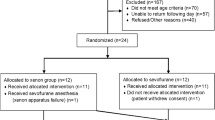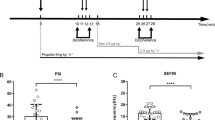Abstract
Objective
We compared two PK/PD models, one with and one without a plateau effect. Bispectral (BIS, Aspect Medical Systems, Natick, MA, version XP) and Narcotrend™ (NCT, MonitorTechnik, Bad Bramstedt, Germany, Version 4.0) indices were used as an electroencephalographic measure of desflurane drug effect.
Methods
With IRB approval and informed consent we investigated 20 adult patients scheduled for radical prostatectomy. At least 45 minutes after induction of general anaesthesia, end-tidal concentrations of desflurane was varied between 3 and 10 vol%. To evaluate the relationship between concentrations and EEG indices, two different pharmacodynamic models were applied: A conventional model based on a single sigmoidal curve, and a novel model based on two sigmoidal curves for BIS and NCT values with and without burst suppression. The parameters of the models␣were estimated by NONMEM V (GloboMax, Hanover, USA) by minimizing log likelihood. Statistical significance between the two models was calculated by the likelihood ratio test.
Results
The maximum end-tidal desflurane concentration during the two concentrations ramps was 10.0 ± 1.4 vol%. The mean BIS and NCT values decreased significantly but slightly with increasing end-tidal desflurane concentrations between 4 and 8 vol%. Therefore a two sigmoidal curves PK/PD model including a plateau describes the effects of desflurane on BIS and Narcotrend better than a single sigmoidal curve model. The difference between the log likelihood values of the new PK/PD model with two connected sigmoidal curves and the classical E max model with one sigmoidal curve is 634 (P < 0.001) for the BIS monitor and 4089 (P < 0.001) for the NCT.
Conclusions
BIS and Narcotrend are not useful to differentiate pharmacodynamic changes in the EEG between 4 and 9 vol% desflurane.
Similar content being viewed by others

References
Johansen JW, Sebel PS. Development and clinical application of electroencephalographic bispectrum monitoring. Anesthesiology 2000; 93: 1336–1344
Rampil IJ. A primer for EEG signal processing in anesthesia. Anesthesiology 1998; 89: 980–1002
Schultz B, Kreuer S, Wilhelm W, Grouven U, Schultz A. The Narcotrend monitor. Development and interpretation algorithms. Anaesthesist 2003; 52: 1143–11148
Kreuer S, Biedler A, Larsen R, Altmann S, Wilhelm W. Narcotrend monitoring allows faster emergence and a reduction of drug consumption in propofol-remifentanil anesthesia. Anesthesiology 2003; 99: 34–41
Kreuer S, Bruhn J, Larsen R, Bialas P, Wilhelm W. Comparability of Narcotrend index and bispectral index during propofol anesthesia. Br J Anaesth 2004; 93: 235–240
Wilhelm W, Kreuer S, Larsen R. Narcotrend EEG monitoring during total intravenous anaesthesia in 4.630 patients. Anaesthesist 2002; 51: 980–988
Kreuer S, Bruhn J, Larsen R, Grundmann U, Wilhelm W. Application of Narcotrend index and bispectral index to the measurement of the EEG effects of isoflurane with and without burst suppression. Anesthesiology 2004; 101: 847–854
Kreuer S, Bruhn J, Walter E, Larsen R, Apfel CC, Grundmann U, Biedler A, Wilhelm W. Comparative pharmacodynamic modeling using bispectral - and Narcotrend-index with and without a pharmacodynamic plateau during sevoflurane anesthesia. Anesth Analg 2008:106(4)
Hill AV. The possible effect of the aggregration of the molecules of hemoglobin on its dissociation curves. J Physiol 1910; 40: iv–vii
Shafer SL. Pharmacokinetic and Pharmacodynamic analysis with NONMEM—basic concepts. Workshop, Palo Alto, California, USA, 9.17.2004
Schnider TW, Minto CF, Shafer SL, Gambus PL, Andresen C, Goodale DB, Youngs EJ. The influence of age on propofol pharmacodynamics. Anesthesiology 1999; 90: 1502–1516
Bruhn J, Bouillon T, Shafer SL. The onset of propofol-induced burst suppression may be correctly detected by approximate entropy but not by the bispectral index. Br J Anaesth 2001; 87: 505–507
Rehberg B, Bouillon T, Zinserling J, Hoeft A. Comparative pharmacodynamic modeling of the electroencephalography-slowing effect of isoflurane, sevoflurane, and desflurane. Anesthesiology 1999; 91: 397–405
Sheiner LB, Stanski DR, Vozeh S, Miller RD, Ham J. Simultaneous modeling of pharmacokinetics and pharmacodynamics: application to d-tubocurarine. Clin Pharmacol Ther 1979; 25: 358–371
Ellerkmann RK, Kreuer S, Wilhelm W, Ropcke H, Hoeft A, Bruhn J. Reduction in anaesthetic drug consumption is correlated with mean titrated intra-operative bispectral index values. Acta Anaesthesiol Scand 2006; 50: 1244–1249
Kreuer S, Bruhn J, Stracke C, Aniset L, Silomon M, Larsen R, Wilhelm W. Narcotrend or bispectral index monitoring during desflurane-remifentanil anesthesia: a comparison with a standard practice protocol. Anesth Analg 2005; 101: 427–434
Yli-Hankala A, Vakkuri A, Annila P, Korttila K. EEG bispectral index monitoring in sevoflurane or propofol anaesthesia: analysis of direct costs and immediate recovery. Acta Anaesthesiol Scand 1999; 43: 545–549
Wong J, Song D, Blanshard H, Grady D, Chung F. Titration of isoflurane using BIS index improves early recovery of elderly patients undergoing orthopaedic surgeries. Can J Anesth 2002; 49: 13–18
Kreuer S, Wilhelm W. The Narcotrend monitor. Best Pract Res Clin Anaesthesiol 2006; 20:111–119
Katoh T, Suzuki A, Ikeda K. Electroencephalographic derivatives as a tool for predicting the dpeth of sedation and anaesthesia induced by sevoflurane. Anesthesiology 1998; 88: 642–650
Olofsen E, Dahan A. The dynamic relationship between end-tidal sevoflurane and isoflurane concentrations and bispectral index and spectral edge frequence of the electroencephalogram. Anesthesiology 1999; 90: 1345–1353
Acknowledgement
This study was solely supported by departmental funding.
Author information
Authors and Affiliations
Corresponding author
Additional information
This study was presented in part at the American Society of Anesthesiologists meeting October 20, 2005 Atlanta.
Kreuer S, Bruhn J, Ellerkmann R, Ziegeler S, Kubulus D, Wilhelm W. Failure of two commercial indexes and spectral parameters to reflect the pharmacodynamic effect of desflurane on EEG.
Rights and permissions
About this article
Cite this article
Kreuer, S., Bruhn, J., Ellerkmann, R. et al. Failure of Two Commercial Indexes and Spectral Parameters to Reflect the Pharmacodynamic Effect of Desflurane on EEG. J Clin Monit Comput 22, 149–158 (2008). https://doi.org/10.1007/s10877-008-9116-1
Received:
Accepted:
Published:
Issue Date:
DOI: https://doi.org/10.1007/s10877-008-9116-1



